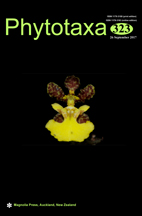Abstract
Tribe Podochileae are a systematically highly challenging orchid group. Although the delimitation of Podochileae is relatively stable and monophyly of this tribe was confirmed by DNA-based phylogenetic analysis (Ng 2002), taxonomic categories within this group have changed frequently. Some groups are well separated morphologically and have been widely accepted as separate genera for a long time, whereas the majority of species was usually placed into a single genus Eria Lindley (1825: 904). Morphological traits have indicated polyphyly of this genus, which led some authors at various times to propose segregate genera. Nevertheless, these concepts were poorly supported by relevant data, and other authors retained these species in Eria s.l. Finally, combined DNA analysis confirmed the polyphyly of Eria (Ng 2002) and resulted in recognition of several previously neglected groups at generic level (Cribb & Ng 2005), including Campanulorchis Brieger (1981: 750).
Campanulorchis was originally proposed by Brieger (1981) with the single species C. globifera Brieger (1981: 750). Seidenfaden (1982, 1992) demonstrated that this species was likely to be closely related to other species of Eria and classified it in Eria sect. Strongylaria Pfitzer (1888: 175). Later, Seidenfaden (1992) suggested separation of E. pannea Lindley (1842: 64) from remaining Indochinese species of E. section Strongylaria. Phylogenetic analyses of Ng (2002) confirmed polyphyly of the section Strongylaria. The type species of E. section Strongylaria, E. pannea, was transferred to Mycaranthes Blume (1825: 352; Chen & Wood 2009), and three of the remaining taxa were transferred to a revised concept of Campanulorchis (Ng & Cribb 2005, Cribb & Ng 2005): C. globifera, C. leiophylla (Lindley 1858: 57) Ng & Cribb (2005: 272) and C. pellipes (Riechenbach in Hooker 1890: 802) Ng & Cribb (2005: 272). Four years later Chen & Wood (2009) added C. thao (Gagnepain 1950: 503) Chen & Wood (2009: 346) because it shares many morphological characters with the other Campanulorchis species, especially with C. globifera. Finally, C. pseudoleiophylla (Wood 1981: 209) Wood (2011: 176) was added (Wood et al. 2011) because this species is morphologically similar to C. leiophylla (Wood 1981). Thus, five species were accepted in the most recent orchid classification (Chase et al. 2015, Govaerts 2017). Here I add two more species to Campanulorchis.

